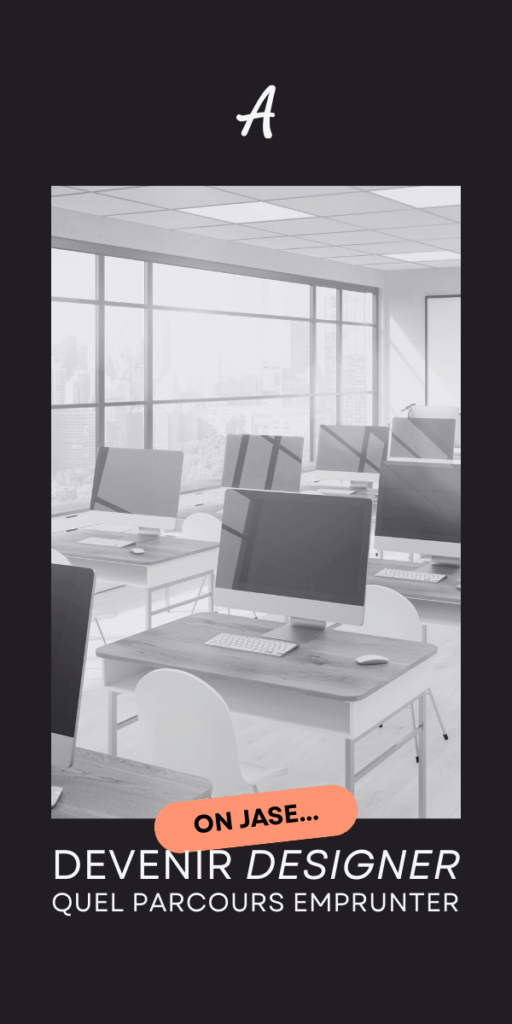The profession of graphic designer is often surrounded by vague ideas. Many people think it’s just about making beautiful drawings or playing with Photoshop, without really knowing what kind of training you need, what skills are required or what we actually do on a daily basis.
In reality, graphic design is a rich and complex field, requiring creativity, a sense of strategy, technical knowledge and a keen understanding of visual communication. And for that, you need solid training!
In Quebec, there are many options for those who want to get started: CEGEP, university or vocational training. Behind every poster, logo or web interface lies a long process of reflection, design and expertise, often underestimated by the general public.
In this article, discover the main routes to becoming a graphic designer in Quebec, the possible specializations and an overview of training content.
Graphic design training: which one to choose?
The opportunities are pretty much the same, but the path you choose will depend on your profile, your ambitions and your learning pace. At Alexem, we believe that it’s your creativity, talent and passion that will take you far, but here are the main routes:
Graphic design technique (DEC – Cégep)
- Duration 3 years
- Where: Cégep de Sherbrooke, Cégep du Vieux Montréal, Cégep de Sainte-Foy, etc.
- For whom? Those who want to enter the job market quickly.
- Features Practical training focused on professional software, concrete projects and mastering the basics of the trade.
Bachelor’s degree in graphic design (University)
- Duration 3 years
- Where? UQAM, Université Laval, Université de Montréal.
- For whom? Those who want to delve deeper into theory, research and creativity.
- Features More creative freedom, research projects, strategic thinking, and a more advanced conceptual approach.
DEP in computer graphics
- Duration 12 to 18 months
- For whom? People undergoing professional retraining or wishing to quickly acquire the technical basics.
- Features Covers page layout, logo creation, illustration, photo retouching, and preparation of files for printing.
These three options are among the most common, but there are also AECs (Attestations d’études collégiales) or hybrid paths combining studies and work experience.
In concrete terms, what do we learn?
When you think of graphic design, the first image that comes to mind is often that of creating logos. Yet this is only a tiny part of the job.
In training, we learn to:
- Analyze customer needs and develop a coherent visual concept
- Structuring information to make it clear and attractive
- Work on the ergonomics and user experience of a website
- Mastering typography and visual hierarchy
- Understanding the psychology of colors and their impact
- Use professional software (Adobe Illustrator, Photoshop, InDesign, After Effects, etc.)
Creativity can’t really be taught. It’s a personal sensitivity that develops over time. But training provides a framework, nurturing and equipping it with the methods, solid foundations and strategic vision needed to move from inspiration to professional realization.
And after graduation?
After graduating, a graphic designer can work in a variety of environments:
- Advertising agencies or design studios: varied projects for multiple clients
- Internal services in companies, municipalities or cultural organizations: long-term visual identity
- Freelance work: freedom to choose your projects and build your clientele
Fields of application
- Print design: posters, brochures, catalogs, packaging
- Digital design: websites, applications, UX/UI interfaces
- Motion design and animation
- Signage and exhibition design
- Publishing and illustration
- Event communication
Graphic design is an evolving field: the need for printed matter persists, but digital is becoming increasingly important. A good designer keeps abreast of trends and new technologies.
Conclusion
Becoming a graphic designer in Quebec means choosing a career at the crossroads of art, communication and strategy. Whatever path you choose, the key is to build a solid portfolio, stay curious and keep learning throughout your career. It’s a profession where every project is a new opportunity to create, innovate and bring to life ideas that will leave a lasting impression.

